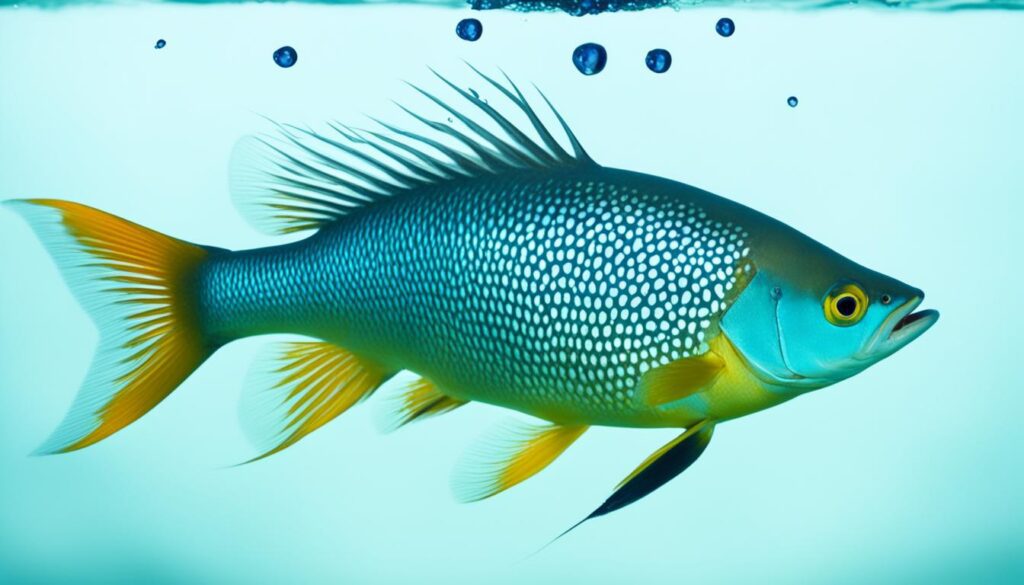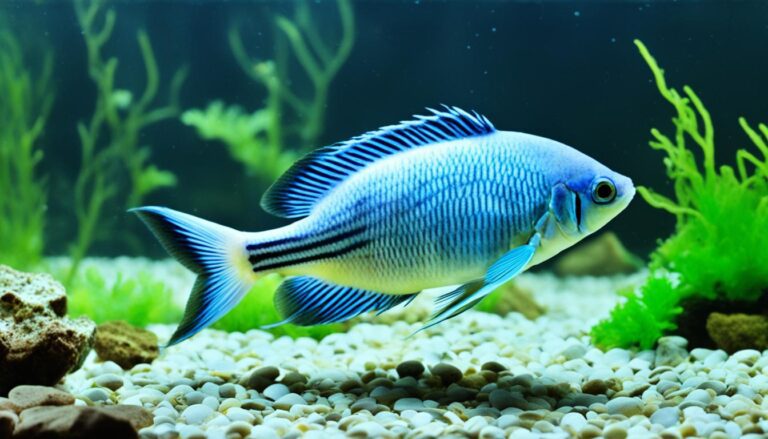As a fish lover, I’m drawn to the beauty of aquarium life. Yet, caring for fish means more than feeding them. It involves noticing if they get sick. Swim bladder disease is one such sickness. It’s common but can be treated. It’s crucial for fish like goldfish and bettas. The disease shows through signs like swimming trouble, bloating, and eating changes. These are ways fish tell us they need help.
When I saw these symptoms, I knew I had to learn more. Finding out that quick action could cure my fish inspired me. Poor eating habits often cause the disease. This includes eating too fast, constipation, and swallowing air. Bad water quality and low temperatures are also to blame. They slow down digestion. This hurts the fish’s swim bladder.
Keeping fish healthy means keeping their home clean. Making sure the water is just right is essential. These steps help prevent swim bladder disease. But if fish get sick, don’t worry. Changing how you feed them and cleaning the water can help. This brings back the balance they need to thrive.
Swim Bladder Disease in Fish

The swim bladder is an organ filled with gas found in bony fish. It’s essential for floating in water without using energy. If the swim bladder doesn’t work right, fish can have serious buoyancy and fish respiratory issues. This affects their health and happiness. Many fish owners don’t fully understand the fish anatomy that affects their pet’s health.
The Role and Anatomy of the Swim Bladder
The swim bladder is located under the backbone. It works like a balloon, inflating or deflating with gas. This lets fish control their buoyancy and move easily in the water. Problems with this organ lead to swim bladder disease. It makes fish float up or sink down without control.
Common Misconceptions About Fish Buoyancy
Many fish owners think all weird swimming is due to swim bladder issues. But, poor water, bad diet, or temperature changes can also cause swimming problems. It’s important to find the real reason to treat it right. This helps keep your fish healthy and living longer.
Species Most Susceptible to Swim Bladder Disorder
Some fish, like fancy goldfish and bettas, are more likely to have swim bladder problems. This is because of how they are bred. These fish have bodies that don’t leave much room for the swim bladder to work properly.
Species |
Percentage Affected by Poor Water Quality |
Common Symptoms |
|---|---|---|
90% |
Lethargy, buoyancy problems |
|
Koi |
99% |
Sinking, inability to maintain buoyancy |
N/A |
Swimming at angles, difficulty reaching the surface |
Identifying Symptoms of Swim Bladder Disease

Spotting fish illnesses early improves outcomes for fish in tanks. Swim bladder disease is common among fish and has specific signs. Knowing these signs is key to help them in time.
Fish with swim bladder problems might swim oddly. They might float too much, sink, or swim at strange angles. If a fish’s belly looks big or its spine is bent, these are serious signs.
Watching how fish eat can tell us about their swim bladder. Fish might stop eating or eat like always, which means we need to watch them closely. It’s critical to check the fish’s living conditions and health soon after spotting these symptoms.
Preventative measures and watching for early signs are very important. Doing regular checks can catch illnesses before they get worse. This keeps your fish friends healthy and happy.
- Watch for fish swimming on their side or upside down.
- Look for difficulties in maintaining buoyancy.
- Observe any changes in appetite or activity levels.
- Note physical alterations such as a curved back or distended belly.
Seeing any of these signs means it’s time for action. You might need to get a fish doctor for advice and treatment.
Proven Treatments for Swim Bladder Disorder

When you start swim bladder treatment in aquariums, early steps are very important. Fish showing signs like swimming difficulties or bloating need quick action. This is to tackle swim bladder disorder symptoms and keep fish healthy.
First Response: Fasting and Water Temperature Adjustments
Starting with a short fasting period is key for swim bladder problems. It usually goes for about three days. Fish fasting eases the swim bladder’s stress from bloating or constipation. At the same time, keep the water between 70 °F and 80 °F. This temperature range aids in recovery.
Feeding Techniques and Dietary Changes
After fasting, reintroduce food gently starting with small, soft, cooked green peas. These peas help with constipation. Keeping the diet filled with easy-to-digest foods like skinned peas is vital. It prevents digestive problems, aiding in swim bladder prevention.
Medical Interventions and Antibiotics
If the problem doesn’t improve or an infection is present, consider antibiotics like Maracyn II. Do this under expert guidance. It’s crucial for fish with severe symptoms or those not helped by diet changes.
When to Seek Veterinary Care for Aquarium Fish Disease
For ongoing swim bladder issues, seeing a fish vet is smart. They can do tests, like X-rays, to find out what’s wrong and suggest specific swim bladder treatment. Sometimes, the kindest choice might be euthanasia if the fish can’t get better.
By caring well for your aquarium fish and acting fast, you can lessen the chances of bad swim bladder disorders. This ensures a healthier, happier home for your fish.
Preventive Strategies for Swim Bladder Issue
To keep fish healthy, especially from swim bladder disorder, we need a strong plan. Clean the tank every two weeks, replacing 25% of the water. This keeps harmful ammonia and nitrate levels low. Goldfish will have a better chance to avoid swim bladder problems in such clean water.
I pay close attention to how I feed my fish to prevent buoyancy issues. Feeding them small amounts they can eat in two minutes helps avoid overfeeding. Before feeding, soaking the food reduces air swallowing, which can lead to swim bladder problems. Also, adding a bit of aquarium salt strengthens their immune system.
If your fish gets sick, it’s key to get veterinary advice. Some home remedies, like feeding fiber-rich peas, can quickly fix constipation. But for serious symptoms, like not eating or odd swimming, see a vet. Catching and treating issues early is essential for your fish’s health.








